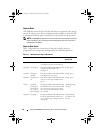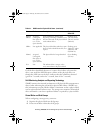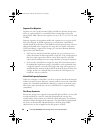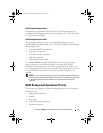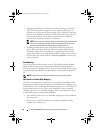
Planning: MD3600i Series Storage Array Terms and Concepts 43
actual storage. RAID 10 is automatically used when a RAID level of 1 is
chosen with four or more physical disks. RAID 10 works well for medium-
sized databases or any environment that requires high performance and fault
tolerance and moderate-to-medium capacity.
Segment Size
Disk striping enables data to be written across multiple physical disks. Disk
striping enhances performance because striped disks are accessed
simultaneously.
The segment size or stripe element size specifies the size of data in a stripe
written to a single disk. The storage array supports stripe element sizes of 8,
16, 32, 64, 128, 256, and 512 KBs. The default stripe element size is 128 KB.
Stripe width, or depth, refers to the number of disks involved in an array
where striping is implemented. For example, a four-disk group with disk
striping has a stripe width of four.
NOTE: Although disk striping delivers excellent performance, striping alone does
not provide data redundancy.
Virtual Disk Operations
Virtual Disk Initialization
Every virtual disk must be initialized. Initialization can be done in the
foreground or the background. A maximum of four virtual disks can be
initialized concurrently on each RAID controller module.
Background Initialization
The storage array executes a background initialization when the virtual disk is
created to establish parity, while allowing full host server access to the virtual
disks. Background initialization does not run on RAID 0 virtual disks. The
background initialization rate is controlled by MDSM. To change the rate of
background initialization, you must stop any existing background
initialization. The rate change is implemented when the background
initialization restarts automatically.
book.book Page 43 Thursday, December 9, 2010 3:20 PM






